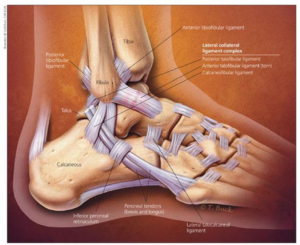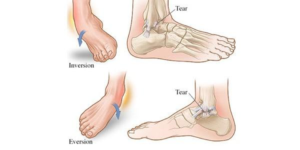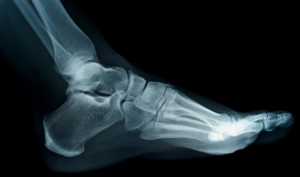Ankle Sprain
 What is an Ankle Sprain?
What is an Ankle Sprain?
A sprained ankle describes an injury caused by rolling, twisting, or turning your ankle, especially in an awkward manner. The sprained ankle can potentially tear or stretch the ligaments that hold the bones together.
Even though over-the-counter pain relievers and self-care measures can help with your ankle sprain injuries, a medical examination and evaluation is necessary. Identifying sprained ankle symptoms and performing diagnosis can reveal the severity of your sprained foot, rule out a fracture, and determine the most appropriate treatment option.
Ankle Sprain Anatomy
Knowing your ankle anatomy ligament is important. This knowledge will help you understand the exact source of pain around your ankle and foot in general. Your ankle is made up of multiple ligaments. These are structures that form a connection between bones. There are also tendons in your ankle, and their main function is to connect muscles to the bone. Tendons allow muscles to exert some force on the associated bones within the ankle.

When an ankle sprain occurs, several ligaments and tendons are also sprained. Here are the two most important ligaments in your ankle:
- Anterior talofibular ligament (ATFL): The ATFL acts as a connector between the talus and the fibula. This ligament is located on the outside of your ankle.
- Calcaneal fibular ligament (CFL): The CFL links the fibula to the calcaneus.
There is also a third ligament in your ankle. This ligament is not easily torn compared to ATFL and CFL. This is because it runs mostly in the back of your ankle. Its name is the posterior talofibular ligament or simply PTFL.
Injuries to ATFL and CFL should be differentiated from injuries such as the high ankle sprain. This type of injury (high ankle sprain) is characterized by a severe ankle sprain involving several ligaments in your foot and ligaments above the ankle joint.
Remember, these ligaments connect the long bone inside your leg (tibia) to the bone located on the outside of your leg (fibula). Your ankle anatomy ligament guides your healthcare provider on what type of treatment to provide in case of foot inversion or tendon tears in the ankle.
Types of Ankle Sprain
 Two types of ankle sprains are known today. They include:
Two types of ankle sprains are known today. They include:
-
Eversion Ankle Sprains
The eversion ankle sprains occur mainly when your ankle rolls outward, causing tears on the deltoid ligaments. In addition, due to a torn ankle ligament, your foot becomes painful, making you not walk properly.
-
Inversion Ankle Sprains
With an inversion sprained ankle, your foot is twisted upward, forcing your ankle to roll inwards. When inversion ankle sprains occur, your ligament or tendon tears in the ankle. This means pain and difficulty in walking or moving the injured foot. The inversion sprained ankle is the more common of these two types of ankle injuries.
Bear in mind that the area around your ankle has three sections. These are lateral, high, and medial. Each one of these three areas is prone to painful ankle sprains.
Lateral ankle sprains are the most common injuries that affect your ankle area’s three sections. Lateral ankle sprains cause injuries on the ligaments that prevent the foot from rolling inward and toward the arch.
High ankle sprains are also called “tib/fib” sprains. They cause injuries to the ankle ligaments that hold the two-leg bones together on top of your ankle. This type of sprain occurs due to a forceful and upward movement of your ankle and foot.
On the other hand, medial ankle sprains cause serious damage to the ligaments on the inside of your ankle ligaments. These ligaments are responsible for keeping your foot from accidentally rolling outward.
Causes and Symptoms of Ankle Sprain
A sprained ankle happens when your foot or ankle is forced out of its position. This type of ankle injury can cause your ankle’s ligaments and tendons to stretch, tear completely or tear partially.
Here are common causes of a sprained ankle you need to know:
- Landing awkwardly on the feet after pivoting or jumping
- A fall that causes the ankle to twist
- Walking, running, or exercising on uneven surfaces
- Someone landing or stepping on your foot during sporting events
Sprained Ankle Symptoms
Signs and symptoms of a sprained foot or sprained ankle may vary depending on the type of the sprain and the severity of your ankle injury. Therefore, sprained ankle symptoms may include:
- Bruising around the injured area
- Swelling at the affected area
- Pain, especially when walking, running, or bearing weight on your sprained foot
- Tenderness when you touch the sprained ankle
- Instability in the sprained ankle
- Limited range of motion
- Popping sensation or popping sound at the time of ankle injury
How To Diagnose Sprained Ankle

Before your ankle sprain treatment starts, your doctor will perform some diagnostic tests. The most common tests include:
- X-Ray: The doctor may suggest an X-ray test to analyze the structure of your injured ankle. This X-ray examination will help rule out a fracture.
- Physical Exam The doctor will be able to rule out the possibilities of other problems affecting your ankle as well as evaluate mobility and integrity of the ankle.
Treatments of Sprained Ankle
Ankle sprain treatment and ankle sprain recovery time will depend on the severity of the sprain. The RICE method (Rest, Ice, Compression, and Elevation) applies to the treatment of sprained ankle. Otherwise, your doctor may suggest any of these treatment options:
1. Nonsurgical Treatment
This form of treatment applies if your sprained ankle is not severe. In this regard, immobilization involving a short leg cast, a splint, or a boot may be used. Also, you can use an ankle sprain brace to allow the healing process to take place without moving the sprained ankle too much. Medication and physical therapy are additional nonsurgical treatment options for your sprained ankle bruising.
2. Surgical Treatment
Surgery for a sprained ankle is rarely needed. But it may be required if your sprained ankle is severe with complete tearing of tendon and ligament. Your surgeon will carry out ankle arthroscopy surgery to repair the torn ligaments.
When to Visit a Healthcare Provider
Make sure to contact your healthcare provider if you feel pain and inflammation in your ankle. Also, seek medical intervention if you suspect that you have an ankle sprain. Dr. Christopher L. Dillingham will certainly help you with your sprained ankle problem.
Dr. Christopher Dillingham is a board-certified orthopedic surgeon and fellowship-trained in lower extremity surgery. He is also experienced in treating arm, forearm, shoulder, elbow, wrist, and hand problems.
The doctors from Sforzo l Dillinghaml Stewart Orthopedic + Sports Medicine are experts and leaders in performing technically difficult surgical procedures using minimally invasive techniques.
Risk Factors of Ankle Sprain

The risk factors associated with tendon tear in the ankle are:
- Sports participation
- Running or walking on uneven surfaces
- History of the sprained ankle injury
- Poor physical condition
- Wearing improper shoes
Prevention of Sprained Ankle
Here are helpful tips that can help you prevent ankle sprains or recurring sprains:
- Take a while to warm up before you start to play sports or exercise
- Watch out when walking, running, or working out on uneven surfaces
- Wear well-fitting pair of shoes
- Avoid wearing high-heeled shoes
- Maintain good muscle flexibility and strength
Final Thought
Ligaments in the ankle play a critical role in helping stabilize joints to prevent excessive movement. Often, an ankle sprain occurs when your ligaments are stretched beyond their elastic limit or normal range of motion. Sprained ankles injuries can extend to the ligaments and tendons on the outer part of your ankle or foot. Ankle sprained treatment depends largely on the severity of your injury. Contact Sforzo | Dillingham | Stewart Orthopedics + Sports Medicine to schedule your consultation appointment.
Conditions Foot & Ankle
Treatment Foot & Ankle
Focusing On You
As healthcare is ever changing, Sforzo | Dillingham | Stewart Orthopedics + Sports Medicine, is doing things differently…
-
 Christopher R. Sforzo, M.D. is a board certified orthopedic surgeon and fellowship trained in hand and upper extremity surgery. He provides expert care in the treatment of problems involving the shoulder, arm, elbow, forearm, wrist and hand. He performs many procedures using minimally invasive techniques includi
Christopher R. Sforzo, M.D. is a board certified orthopedic surgeon and fellowship trained in hand and upper extremity surgery. He provides expert care in the treatment of problems involving the shoulder, arm, elbow, forearm, wrist and hand. He performs many procedures using minimally invasive techniques includi -
 Christopher L. Dillingham, M.D. is a board certified orthopedic surgeon and fellowship trained in hand, shoulder, and arm surgery. He specializes in the treatment of problems with rotator cuff disorders, carpal tunnel syndrome and nerve injury, joint replacement, arthritis surgery, fracture repair, foot and ankle
Christopher L. Dillingham, M.D. is a board certified orthopedic surgeon and fellowship trained in hand, shoulder, and arm surgery. He specializes in the treatment of problems with rotator cuff disorders, carpal tunnel syndrome and nerve injury, joint replacement, arthritis surgery, fracture repair, foot and ankle -
 Charles E. Stewart M.D. is a board certified, Johns Hopkins fellowship-trained orthopedic surgeon specializing in adult complex reconstruction of the lower extremity. His specialties include, lower extremity sports injuries, meniscal injuries, partial knee replacement, total hip and knee arthroplasty (replacement), as
Charles E. Stewart M.D. is a board certified, Johns Hopkins fellowship-trained orthopedic surgeon specializing in adult complex reconstruction of the lower extremity. His specialties include, lower extremity sports injuries, meniscal injuries, partial knee replacement, total hip and knee arthroplasty (replacement), as -
 Philip A. Meinhardt, M.D. is a board certified orthopedic surgeon and fellowship trained spine surgeon. He specializes in adult spinal surgeries including reconstruction of spinal deformities, minimally invasive/microscopic spinal procedures, decompression, spinal instrumentation, fusion procedures and microscopic cer
Philip A. Meinhardt, M.D. is a board certified orthopedic surgeon and fellowship trained spine surgeon. He specializes in adult spinal surgeries including reconstruction of spinal deformities, minimally invasive/microscopic spinal procedures, decompression, spinal instrumentation, fusion procedures and microscopic cer
Testimonial
Latest Blog Posts
-
 October 18, 2022Dr. Christopher Sforzo was invited to speak at the recent IMG Academy Athlet
October 18, 2022Dr. Christopher Sforzo was invited to speak at the recent IMG Academy Athlet -
 January 22, 2022Did you know that pickleball has become the fastest-growing sport in the U.S.? It’s a fun
January 22, 2022Did you know that pickleball has become the fastest-growing sport in the U.S.? It’s a fun -
 October 27, 2021SARASOTA, FL – With the fall football season underway, shoulder injuries are on the rise among
October 27, 2021SARASOTA, FL – With the fall football season underway, shoulder injuries are on the rise among













